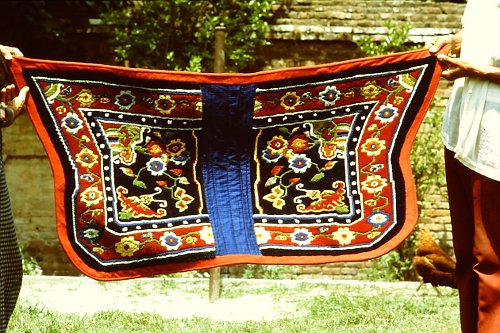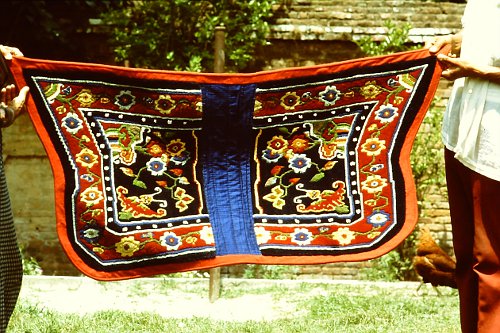| < Prev | Next > |
|---|
 A wild Tibetan horseman on a sturdy, short-legged horse in combination with a colorful Tibetan saddle rug. That makes a nice picture! Right.
A wild Tibetan horseman on a sturdy, short-legged horse in combination with a colorful Tibetan saddle rug. That makes a nice picture! Right.
But that is not the real reason why Tibetans used saddle rugs. It is by far more trivial. The Tibetan saddles were made out of wood. And horse and rider needed some kind of padding.
Read the whole story about Tibetan saddle rugs.
For the Comfort of the Horse and the Rider
Saddle rugs are a specific genre within the product class of Tibetan rugs. It is a combination of two pieces. A rectangular rug is placed on top of the saddle - for the comfort of the rider. And a larger rug in an unusual shape is placed below the saddle - for the comfort of the horse.
Gallery of Tibetan Saddle Rugs
But let us start with a few images of Tibetan saddle rugs. I took these pictures around 1980. The saddle rugs were newly made. By then hardly anyone made any new saddle rugs to my knowledge - due to a lack of demand. The pieces were made by Tibetans from the Khampa people, formerly the wild guys from the Tibetan eastern provinces Kham and Amdo.
Saddle Rugs Made by Wild Khampa Tibetans
I do not know for sure why they had made these pieces (as far as I remember as presents for their loved ones in Tibet). They told me that they had only one woman in their camp who was still capable of making these saddle rugs. I acquired one pair and photographed the rest. This group of Khampas had fought a guerilla war against the Chinese communists in Tibet out of the formerly restricted area of Upper Mustang in Nepal, secretly supported by the American CIA.
In the early 1970s, when the USA under President Nixon and Secretary of State Henry Kissinger approached China to end the involvement in Vietnam, the Khampa guerilla warriors in Mustang (about 6,000) had suddenly become an obstacle in US policies. Under pressure by the USA and with the help of a taped message by the Dalai Lama, Nepalese authorities could disarm the Khampas in Upper Mustang. The Nepalese resettled them in different camps all over Nepal. In the late 1970s I got to know one of of these camps. It was east of Bodnath. That was by the way my first encounter with Tibetans and Tibetan rugs.
Saddle Rugs - for the Horse and the Rider
But I am deviating from the subject. Let's get back to Tibetan saddle rugs and their primary purpose - protecting the horse's back and the rider's backside. In order to meet this purpose, the lower part that is placed under the saddle for the horse's comfort, must be well bolstered. The middle part that you see in blue on the images is made of cotton with some padding material inside.
Both parts of the saddle rug have a thick, dense tile. The red borders are made of felt. This is a technique that you often find with old Tibetan rugs in general. But it is not used in today's Tibetan carpet making any longer.
The designs are not different from the ones of normal, traditional Tibetan rugs.
In contrast to ordinary rugs, the backside of the saddle carpets has a cotton cloth.
Tibetan Saddle Rugs - a Thing of the Past
Tibetan saddle rugs exist today only as old, antique pieces (Please correct me if I am wrong.). As everything antique, they are expensive. And a complete pair of two pieces is rather rare.
PS: Allow me to deviate from the subject a second time. Tibetans usually treat animals well. Tibetans are Buddhists and believe in rebirths. Thus, the new horse that they ride might be a reincarnation of their own grandfather who had deceased some time ago. That explains it all! 
Dieter Wanczura, October 2010.





















